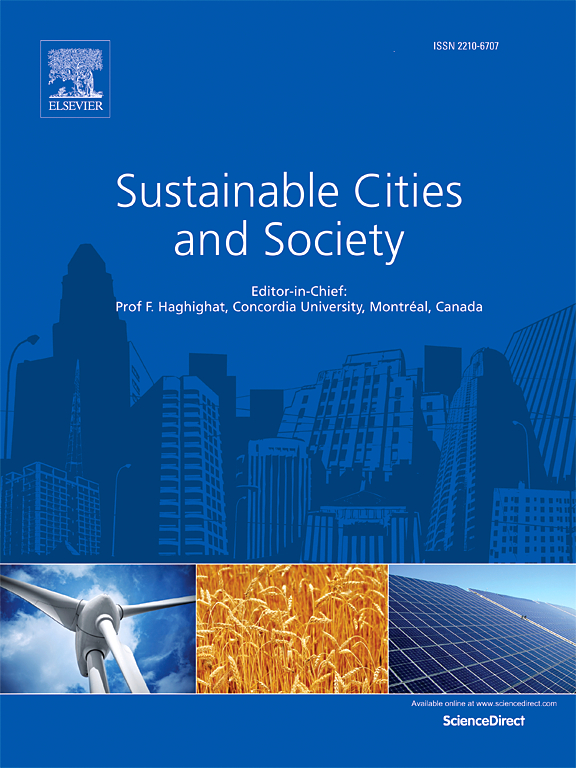Exploring the integrating factors and size thresholds affecting cooling effects in urban parks: A diurnal balance perspective
IF 10.5
1区 工程技术
Q1 CONSTRUCTION & BUILDING TECHNOLOGY
引用次数: 0
Abstract
Urban parks play a key role in mitigating urban heat island effects, yet the diurnal dynamics influencing their cooling performance remain insufficiently explored. This study investigated the diurnal variations in cooling effects across different types of urban parks in Fuzhou, China. Using multiple stepwise regression, the influence of two-dimensional (2D) and three-dimensional (3D) factors on diurnal cooling patterns was assessed. Additionally, cooling thresholds were identified based on the law of diminishing marginal utility. Results indicated that the park cooling intensity (PCI), park cooling gradient (PCG) and park cooling area (PCA) generally increased with park size throughout the day, whereas the park cooling efficiency (PCE) declined. The key determinants of cooling effects varied with park types: the difference between the contribution of 2D and 3D factors to the cooling effect of small and medium parks was not significant throughout the day, whereas large parks were primarily influenced by 2D factors. Buffer characteristics significantly affected cooling effects of all park types. The threshold value of cooling efficiency (TVoE) and the threshold value of cooling benefit (TVoB) varied across park types and exhibited temporal dynamics. These findings support balanced strategies for diverse urban parks' cooling goals from an all-weather perspective, effectively addressing urban heat challenges.
影响城市公园降温效果的综合因子和规模阈值:日平衡视角
城市公园在缓解城市热岛效应方面发挥着关键作用,但影响城市公园降温性能的日动力学机制尚未得到充分探讨。研究了福州市不同类型城市公园降温效果的日变化规律。采用多元逐步回归方法,评估了二维(2D)和三维(3D)因素对日冷却模式的影响。此外,根据边际效用递减规律确定了冷却阈值。结果表明:随着公园规模的增大,公园降温强度(PCI)、降温梯度(PCG)和降温面积(PCA)总体呈上升趋势,而公园降温效率(PCE)呈下降趋势;影响降温效果的关键因素随公园类型的不同而不同:中小型公园的2D和3D因素对全天降温效果的贡献差异不显著,而大型公园主要受2D因素的影响。缓冲特性显著影响所有公园类型的降温效果。降温效率阈值(TVoE)和降温效益阈值(TVoB)在不同公园类型间存在差异,并表现出时间动态特征。这些发现支持从全天候角度为不同城市公园的冷却目标提供平衡策略,有效解决城市热挑战。
本文章由计算机程序翻译,如有差异,请以英文原文为准。
求助全文
约1分钟内获得全文
求助全文
来源期刊

Sustainable Cities and Society
Social Sciences-Geography, Planning and Development
CiteScore
22.00
自引率
13.70%
发文量
810
审稿时长
27 days
期刊介绍:
Sustainable Cities and Society (SCS) is an international journal that focuses on fundamental and applied research to promote environmentally sustainable and socially resilient cities. The journal welcomes cross-cutting, multi-disciplinary research in various areas, including:
1. Smart cities and resilient environments;
2. Alternative/clean energy sources, energy distribution, distributed energy generation, and energy demand reduction/management;
3. Monitoring and improving air quality in built environment and cities (e.g., healthy built environment and air quality management);
4. Energy efficient, low/zero carbon, and green buildings/communities;
5. Climate change mitigation and adaptation in urban environments;
6. Green infrastructure and BMPs;
7. Environmental Footprint accounting and management;
8. Urban agriculture and forestry;
9. ICT, smart grid and intelligent infrastructure;
10. Urban design/planning, regulations, legislation, certification, economics, and policy;
11. Social aspects, impacts and resiliency of cities;
12. Behavior monitoring, analysis and change within urban communities;
13. Health monitoring and improvement;
14. Nexus issues related to sustainable cities and societies;
15. Smart city governance;
16. Decision Support Systems for trade-off and uncertainty analysis for improved management of cities and society;
17. Big data, machine learning, and artificial intelligence applications and case studies;
18. Critical infrastructure protection, including security, privacy, forensics, and reliability issues of cyber-physical systems.
19. Water footprint reduction and urban water distribution, harvesting, treatment, reuse and management;
20. Waste reduction and recycling;
21. Wastewater collection, treatment and recycling;
22. Smart, clean and healthy transportation systems and infrastructure;
 求助内容:
求助内容: 应助结果提醒方式:
应助结果提醒方式:


